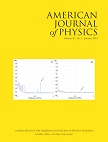
January 2019 Issue,
Volume 87, No. 1
The first direct detection of gravitational waves by the Laser Interferometer Gravitational-Wave Observatory (LIGO) in September 2015 proved their existence, as predicted by Einstein's General Theory of Relativity, and ushered in the era of gravitational-wave interferometry. In this article, we present a set of lab course experiments at different levels of advancement, which give students insight into the basic LIGO operating principle and advanced detection techniques. Starting with methods for folding an optical cavity, we advance to analogy experiments with sound waves that can be detected with a Michelson interferometer with an optical cavity arm. In that experiment, students also learn how the sensitivity of the device can be tuned. In a last step, we show how optical heterodyne detection (the mixing of a signal with a reference oscillator) was used in Initial LIGO. We hope these experiments not only give students an understanding of some LIGO techniques but also awaken a fascination for how unimaginably tiny signals, created by powerful cosmic events a billion years ago or earlier, can be detected today here on Earth.
Papers
Comoving frames and the Lorentz–Fitzgerald contraction by Alon Drory. DOI: /10.1119/1.5082535
Analytical solution of gravity tunnels through an inhomogeneous Earth byStefan Isermann. DOI: 10.1119/1.5075717
Flying in formation: The orbital dynamics of LISA's three spacecraft by Joseph C. Amato. DOI: 10.1119/1.5075722
Laboratory demonstration of acoustic source localization in two dimensions by Frank Lamelas, and Sudha Swaminathan. DOI: 10.1119/1.5078510
Reliable determination of contact angle from the height and volume of sessile drops by F. Behroozi, and P. S. Behroozi. DOI: /10.1119/1.5078512
The Fluidyne engine by Alejandro Romanelli. DOI: 10.1119/1.5078518
Observation of the Talbot effect with water waves by Alexandra Bakman, Shmuel Fishman, Mathias Fink, Emmanuel Fort, and Sander Wildeman. DOI: 10.1119/1.5081051
Apparatus and Demonstration Notes
LIGO analogy lab—A set of undergraduate lab experiments to demonstrate some principles of gravitational wave detection by Dennis Ugolini, Hanna Rafferty, Max Winter, Carsten Rockstuhl, and Antje Bergmann. DOI: 10.1119/1.5066567
PHYSICS EDUCATION RESEARCH
Taking teachers' ideas seriously: Exploring the role of physics faculty in preparing teachers in the era of the Next Generation Science Standards by Amy D. Robertson, Lane Seeley, Orlala T. Wentink, and Stamatis Vokos. DOI: 10.1119/1.5082286
COMPUTATIONAL PHYSICS
Stability of planetary systems: A numerical didactic approach by Renato Pakter, and Yan Levin. DOI: 10.1119/1.5079541
BACK OF THE ENVELOPE
Don't demean the geometric mean by Sanjoy Mahajan. DOI: 10.1119/1.5082281
Book Reviews
Books Received
American Journal of Physics 87, 79 (2019); DOI: 10.1119/1.5082182
About AJP
General Information, Resources for Authors, Reviewers, and Readers

